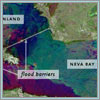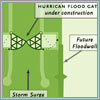

|
|
Netherlands: Problem
This image could have been taken in Katrina's wake, but it was actually
captured more than a decade ago and an ocean away from Louisiana. Periodic
flooding has plagued the Netherlands since the Middle Ages. Half the country,
including Amsterdam and Rotterdam, lies below sea level in a drainage basin for
three rivers and at the door of the North Sea. A catastrophic flood in 1953
killed nearly 2,000 people and destroyed whole villages; afterward, the Dutch
vowed never again.
|


|
|
Netherlands: Solution
Dutch engineers finally completed their country's sophisticated flood defenses
in 1997. The result is an $8 billion system of enormous, computer-operated dams
and sea surge barriers. The system is admired around the world as an engineering marvel.
The floodgates, parts of which are seen here, remain open ordinarily, allowing
river water to flow into the sea, but they are quickly lowered during storms.
Built to withstand the kind of tremendous flood estimated to occur only once in
10,000 years, the gates have so far done their job successfully.
|


|
|
St. Petersburg: Problem
St. Petersburg, Russia is one of the most fabled of waterlogged cities. Its
battles with flooding have been immortalized for centuries in Russian art (such
as in this painting) and in literature. The city was built atop a swamp fed by the
Neva River and the Gulf of Finland. Each fall and winter, strong winds and ice
block the flow of the Neva into the Gulf, causing the river level to rise and,
at least once a year, spill excess water into the city. Over the years, several
disastrous floods, including the two largest in 1824 and 1924, have left
considerable death and destruction in their wake.
|


|
|
St. Petersburg: Solution
In 1980, the Soviet government began to erect a pair of massive storm surge barriers on either side of a small island
in the Neva. With the project nearly 65 percent complete, financial problems and environmental
concerns brought it to halt less than 10 years later. But in 2003, with new foreign funding and
a plan to keep the river healthy, the project was revived. Construction is now under way to
finish the barriers, seen here, which will shut during storms and hopefully spare St. Petersburg
any more high-water floods.
|


|
|
London: Problem
Londoners are characteristically blasé about their flood-prone city, but
the tidal Thames River, which carves through its center, has a history of
severe flooding. The threat of high tides has increased over time due to a slow
but continuous overall rise in the river's water level, which experts attribute
to climate change and the gradual settling of the city.
|


|
|
London: Solution
In the 1970s, the so-called Thames Barrier, seen here, was built across the
river to protect London from the kind of disastrous flooding that last occurred
there in 1953 (when Holland also flooded) and took over 300 lives. But
scientists say that the defense the barrier provides is gradually declining,
and it may not be able to continue to block rising tides past the year 2030.
Officials have charged a commission with finding a longer-lasting solution, and
a proposal is under consideration to build a more extensive, 10-mile gated
barrier along the Thames.
|


|
|
Venice: Problem
Venetian scenes like this one have become almost as representative of the city
as its gondolas and elegant architecture. The ground on which Venice lies is
famously sinking. This, combined with rising sea levels and periodic storms
that cause the Adriatic Sea to flood Venice's lagoon, creates a phenomenon
known as acqua alta, or high water—in other words, flooding.
Venetians have dealt with the rising water for centuries by raising the level
of floors in buildings and the pavement along city canals, but powerful storms
can still prove destructive.
|


|
|
Venice: Solution
This mobile flood barrier embodies the most substantial engineering aspect of
the proposed solution to flooding in Venice. It is part of a
multibillion-dollar series of 78 metal gates that will rise off the seafloor at
the three entrances to Venice's lagoon whenever acqua alta is forecast,
blocking the Adriatic until high tides subside. This project has been
controversial, with many experts concerned for the environmental health of the
lagoon and advising against what may be only a relatively short-term solution.
But the gates are slated to be completed in 2011.
|


|
|
San Antonio: Problem
Texas is one of America's most flood-vulnerable states. Severe rains can cause
water to rise across dozens of counties quickly and simultaneously, destroying
homes and highways and threatening the downtown areas of major cities such as
Houston and San Antonio. In 2002, as much as two feet of rain fell on
southeastern Texas in a week, flooding three major river systems along the Gulf
of Mexico and inundating highways such as this one outside of Houston.
|


|
|
San Antonio: Solution
Experts consider San Antonio's anti-flood approach among the most innovative
solutions to flooding in any metropolitan area. Between 1987 and 1996, federal
and local governments funded the construction of a 16,200-foot concrete
flood-diversion tunnel beneath the city. It siphons rainfall out of populated
areas and carries it to the San Antonio River. Fully 24 feet in diameter, the
tunnel was dug with a massive tunnel-boring machine, seen here in action
beneath San Antonio.
|


|
|
New Orleans: Problem
Immediately after Katrina—and even before—officials began
brainstorming new flood protection infrastructure. Tailor-made for New Orleans,
it would replace or bolster the city's existing levees. It's still
too soon to know what the plan will be, but in hundreds of television
appearances, radio interviews, lectures, op-ed articles, and scientific papers,
the experts have weighed in with a wide range of ideas, from aggressively
restoring Louisiana's naturally defensive delta and saltwater marshes, to
mobile floodgates, to high-tech, electronically sensitive levees.
|


|
|
New Orleans: Solution
One new idea for New Orleans was already in development before Katrina.
Construction has begun on a sophisticated hurricane floodgate that would close
across the Harvey Canal in the event of a storm surge. The $36 million
floodgate will protect 250,000 people in the West Bank area of New Orleans,
which was relatively unscathed by Katrina, from another storm. When the new
barriers are finished, they will be the first hurricane-specific canal barriers
of their kind in New Orleans and most likely the first new flood proofing in
the city since Katrina.
|

| 
|

